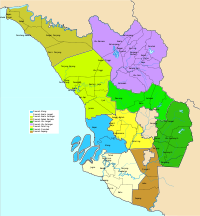Gombak District
The Gombak District is an administrative district located in the state of Selangor, Malaysia. The district was created on February 1, 1974, the same day when Kuala Lumpur was declared a Federal Territory. Until 1997, Rawang was the district capital; the capital has been moved to Bandar Baru Selayang. Gombak borders Kuala Lumpur to the southeast and the Genting Highlands to the east. Both Gombak and Kuala Lumpur, along with some other districts in Selangor, are situated within the Klang Valley. Other localities that are situated in Gombak district include Batu Arang, Kuang, Rawang, Bandar Kundang, Gombak Town, Selayang, Kepong and Hulu Kelang.
Gombak District | |
|---|---|
| Daerah Gombak | |
| Other transcription(s) | |
| • Jawi | ڬومبق |
| • Chinese | 鹅唛县 (Simplified) 鵝嘜縣 (Traditional) |
| • Tamil | கோம்பாக் |
 Location of Gombak District in Selangor Darul Ehsan | |
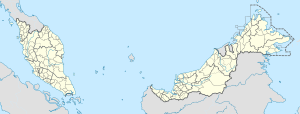 Gombak District Location of Gombak District in Malaysia | |
| Coordinates: 3°16′27.3″N 101°34′14.6″E | |
| Country | |
| State | |
| Seat | Bandar Baru Selayang |
| Local area government(s) | Selayang Municipal Council (West) Ampang Jaya Municipal Council (East) |
| Government | |
| • District officer | Amirul Azizan Abdul Rahim[1] |
| • Sultan's Representative | Wan Mahmood Pawanteh[2] |
| Area | |
| • Total | 650.08 km2 (251.00 sq mi) |
| Population (2010)[4] | |
| • Total | 629,971 |
| • Density | 970/km2 (2,500/sq mi) |
| Time zone | UTC+8 (MST) |
| • Summer (DST) | UTC+8 (Not observed) |
| Postcode | 48xxx, 52xxx-54xxx, 68xxx |
| Calling code | +6-03-41, +6-03-60, +6-03-61, +6-3-62 |
| Vehicle registration plates | B |
The International Islamic University Malaysia (IIUM/UIAM) main campus is also located here as well as the Batu Caves. Gombak is also home to an aboriginal Orang Asli settlement, and it is the site of the Orang Asli Museum.
Gombak River merges with the larger Klang River in Kuala Lumpur. The meeting place of the two rivers is the birthplace of Kuala Lumpur. At the center of the confluence is the Masjid Jamek.
Bird flu struck both Gombak and the Setapak areas in March 2006 without causing any fatalities.
Gombak (town) also refers to as a locality (town/area/suburb) in the northern and central portion of the Setapak subdistrict (both in Gombak and Kuala Lumpur). Before 1974, Gombak was a town before it became a district. Gombak was home to the settlements of the first Minangkabau immigrants in the 1800s and was established soon after. Old mosques in the Gombak area such as the Masjid Lama Batu 6 Gombak are still standing to this day. Today, Gombak can be referred to both the town and district itself but the local's usually refers Gombak as the town, not the district.
Administrative divisions
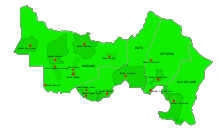
Gombak District is divided into 4 mukims, which are:
Government
Gombak is partly administrated by two different local governments completely within it, which fall under the state jurisdiction, not the district:
- Ampang Jaya Municipal Council (among Ampang city area)
- Selayang Municipal Council (other parts of the district)
Demographics
The following is based on Department of Statistics Malaysia 2010 census.[4]
| Ethnic groups in Gombak , 2010 census | ||
|---|---|---|
| Ethnicity | Population | Percentage |
| Bumiputera | 396,012 | 62.9% |
| Chinese | 147,488 | 23.4% |
| Indian | 76,773 | 12.2% |
| Others | 9,698 | 1.5% |
| Total | 629,971 | 100% |
Education
National education is under the purview of the Gombak District Education Office. As of 2014, there were 53 national type primary schools, eight national type (Chinese) primary schools, seven national type (Tamil) primary schools, 30 national type secondary schools (SMK), two national type secondary boarding schools (SM Berasrama Penuh), two national type secondary Islam religious school (SM Agama) and two national type secondary vocational schools (Kolej Vokasional)
Tourist attractions
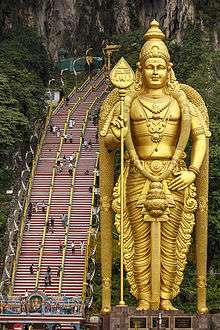
Gombak has a large amount of recreational area and tourist attraction.
- Batu Caves
- Forest Research Institute Malaysia
- Batu Dam, Batu Caves
- Gua Damai Extreme Park, Batu Caves
- Batu Arang Heritage Town
- Orang Asli Museum, Gombak
- Hutan Lipur Bukit Lagong, Selayang
- Hutan Lipur Sungai Tua, Selayang
- Kancing Forest Park, Rawang
- Selayang Hot Spring, Selayang
- Commonwealth Forest Park, Rawang
- Templer Park, Rawang
- Tasik Biru Kundang, Kundang
- National Zoo of Malaysia
- Klang Gates Dam
- Batu Asah Waterfall, Hulu Kelang
- Ampang Forest Reserve, Hulu Kelang
- Selangor Fruit Valley, BAtu Arang
Federal Parliament and State Assembly Seats
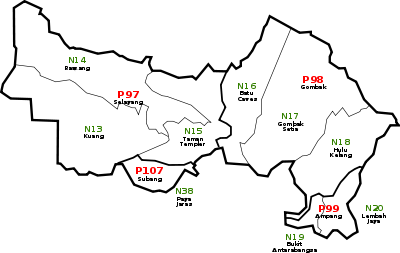
List of Gombak district representatives in the Federal Parliament (Dewan Rakyat)
| Parliament | Seat Name | Member of Parliament | Party |
|---|---|---|---|
| P97 | Selayang | William Leong Jee Keen | Pakatan Harapan (PKR) |
| P98 | Gombak | Mohamed Azmin Ali | Perikatan Nasional (BERSATU) |
| P99 | Ampang | Zuraida Kamarudin | Perikatan Nasional (BERSATU) |
| P106 | Damansara | Tony Pua Kiam Wee | Pakatan Harapan (DAP) |
| P107 | Sungai Buloh | Sivarasa K. Rasiah | Pakatan Harapan (PKR) |
List of Gombak district representatives in the State Legislative Assembly (Dewan Undangan Negeri)
| Parliament | State | Seat Name | State Assemblyman | Party |
|---|---|---|---|---|
| P97 | N13 | Kuang | Sallehudin bin Amiruddin | Pakatan Harapan (PKR) |
| P97 | N14 | Rawang | Chua Wei Kiat | Pakatan Harapan (PKR) |
| P97 | N15 | Taman Templer | Mohd Sany bin Hamzan | Pakatan Harapan (Amanah) |
| P98 | N16 | Sungai Tua | Amirudin Shari | Pakatan Harapan (PKR) |
| P98 | N17 | Gombak Setia | Muhammad Hilman bin Idham | IND |
| P98 | N18 | Hulu Kelang | Saari Sungib | Pakatan Harapan (Amanah) |
| P99 | N19 | Bukit Antarabangsa | Mohamed Azmin Ali | Perikatan Nasional (BERSATU) |
| P99 | N20 | Lembah Jaya | Haniza binti Mohamed Talha | Pakatan Harapan (PKR) |
| P106 | N37 | Bukit Lanjan | Wong Keat Ping | Pakatan Harapan (PH) |
| P107 | N38 | Paya Jaras | Mohd Khairuddin bin Othman | Pakatan Harapan (PKR) |
Transportation
By Rail
- Batu Caves station serve the KC05 KTM Komuter train service.
- Kepong Sentral station serve the KA07 KTM Komuter, KTM Intercity, KTM ETS and SSP04 MRT SSP train services.
- Gombak station is the only LRT lines thru Gombak district and also has only one station which is KJ1 LRT KJ
- Sungai Buloh station is an interchange station to cater the train services for KA08 KTM Komuter, KTM Intercity, KTM ETS and SBK01 MRT Sungai Buloh-Kajang Line
- Rawang station is one of the main station that serve KA10 KTM Komuter, KTM Intercity and KTM ETS train services.
- Kuang station only serve by KA09 KTM Komuter train service.
By Car






References
- "Portal Rasmi PDT Gombak Perutusan Pegawai Daerah Gombak". www2.selangor.gov.my.
- "Portal Rasmi PDT Gombak Orang Besar Daerah Gombak". www2.selangor.gov.my.
- "Portal Rasmi PDT Gombak Profil Gombak". www2.selangor.gov.my.
- "Population Distribution and Basic Demographic Characteristics, 2010" (PDF). Department of Statistics, Malaysia. Archived from the original (PDF) on 22 May 2014. Retrieved 19 April 2012.
